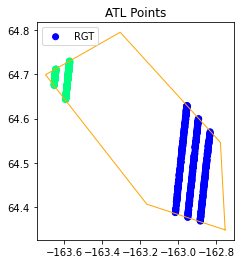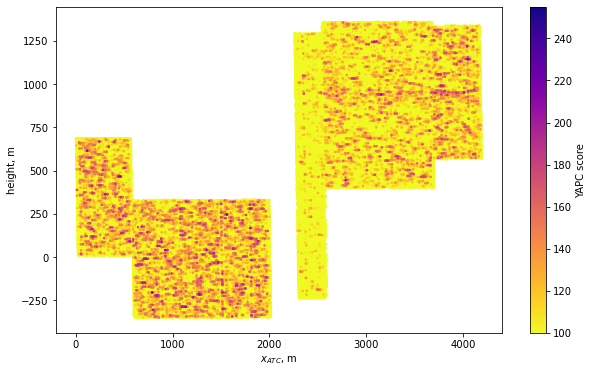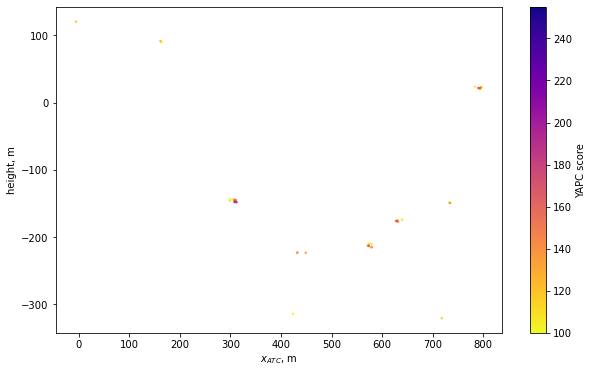Slide Rule example
From the SlideRule documentation, “SlideRule is a web service for on-demand science data processing, which provides researchers and other Earth science data systems low-latency access to customized data products using processing parameters supplied at the time of the request. SlideRule runs in AWS us-west-2 and has access to the official ICESat-2 datasets hosted by the NSIDC.” See the documentation for installation instructions.
Step 1: Install packages
import matplotlib.pyplot as plt
from sliderule import icesat2
from ipyleaflet import Map, GeoData, LayersControl,Rectangle, basemaps, basemap_to_tiles, TileLayer, SplitMapControl, Polygon
---------------------------------------------------------------------------
ModuleNotFoundError Traceback (most recent call last)
Input In [1], in <cell line: 1>()
----> 1 import matplotlib.pyplot as plt
2 from sliderule import icesat2
3 from ipyleaflet import Map, GeoData, LayersControl,Rectangle, basemaps, basemap_to_tiles, TileLayer, SplitMapControl, Polygon
ModuleNotFoundError: No module named 'matplotlib'
Import the functions from our coastal library. The library is at ../ so we need to append that to the Python path.
import sys
sys.path.append('../')
from coastal.beam import reduce_dataframe
from coastal.plot import plot_atl08, plot_yapc
Step 2: Initialize the icesat2 package
icesat2.init("icesat2sliderule.org", verbose=True)
Step 3: Create a list of coordinates
Here we will import a geojson file that represents the White Mountain, Alaska region of interest. Our geojson file looks like so
{"type":"FeatureCollection","features":[{"type":"Feature","properties":{},"geometry":{"type":"Polygon","coordinates":[[[-163.16619873046875,64.4064312702572],[-162.75421142578125,64.34823209154665],[-162.77893066406247,64.54607936653424],[-163.3062744140625,64.79518717004242],[-163.69903564453122,64.69910544204765],[-163.16619873046875,64.4064312702572]]]}}]}
We have this saved to a file whitemountain.geojson.
# import the map.geojson file representing the ROI
spatialExtent = icesat2.toregion('data/whitemountain.geojson')["poly"]
# check the format of the coordinates
spatialExtent
[{'lon': -162.75421142578125, 'lat': 64.34823209154665},
{'lon': -162.77893066406247, 'lat': 64.54607936653424},
{'lon': -163.3062744140625, 'lat': 64.79518717004242},
{'lon': -163.69903564453122, 'lat': 64.69910544204765},
{'lon': -163.16619873046875, 'lat': 64.4064312702572},
{'lon': -162.75421142578125, 'lat': 64.34823209154665}]
# create bounding box
bb = [spatialExtent[0]['lon'], spatialExtent[0]['lat'],
spatialExtent[2]['lon'], spatialExtent[2]['lat']]
# create polygon for plotting
polygon = Polygon(
locations=spatialExtent,
color="green"
)
Step 4: Visualize region of interest
center = [spatialExtent[0]['lat'], spatialExtent[0]['lon']]
zoom = 8
m = Map(basemap=basemaps.Esri.WorldImagery, center=center, zoom=zoom)
m.add_layer(polygon);
m
Step 5: Create a dictionary of processing parameters
These will specify how the elevations (from ATL03 photon data) for the region should be calculated.
%%time
# build sliderule parameters for ATL03 subsetting request
# SRT_LAND = 0
# SRT_OCEAN = 1
# SRT_SEA_ICE = 2
# SRT_LAND_ICE = 3
# SRT_INLAND_WATER = 4
parms = {
# processing parameters
"srt": icesat2.SRT_LAND,
"len": 20,
# classification and checks
# still return photon segments that fail checks
"pass_invalid": True,
# all photons
"cnf": -2,
# all land classification flags
"atl08_class": ["atl08_noise", "atl08_ground", "atl08_canopy", "atl08_top_of_canopy", "atl08_unclassified"],
# all photons
"yapc": dict(knn=0, win_h=6, win_x=11, min_ph=4, score=0),
}
CPU times: user 5 µs, sys: 1e+03 ns, total: 6 µs
Wall time: 8.58 µs
Set the data asset, release and time boundaries for query
# Set ICESat-2 data asset
asset = "nsidc-s3"
# ICESat-2 data release
release = '005'
# time bounds for CMR query
time_start = '2019-07-10'
time_end = '2019-07-20'
Step 6: Find the granules
This code will find the granules, create an empty geodataframe and write the query into the geodataframe.
# find granule for each region of interest
granules_list = icesat2.cmr(polygon=spatialExtent, time_start=time_start, time_end=time_end, version=release)
# create an empty geodataframe
parms["poly"] = spatialExtent
# write output into geodataframe
gdf = icesat2.atl03sp(parms, asset=asset, version=release, resources=granules_list)
INFO:sliderule.icesat2:Allocating 21 workers across 7 processing nodes
INFO:sliderule.icesat2:0 points returned for ATL03_20190710014600_01830405_005_01.h5 (1 out of 3 resources)
INFO:sliderule.icesat2:1361414 points returned for ATL03_20190714013741_02440405_005_01.h5 (2 out of 3 resources)
INFO:sliderule.icesat2:874960 points returned for ATL03_20190718012923_03050405_005_01.h5 (3 out of 3 resources)
# look at the resulting geodataframe
gdf.head()
| segment_id | segment_dist | track | cycle | rgt | sc_orient | delta_time | atl03_cnf | height | distance | atl08_class | yapc_score | quality_ph | pair | geometry | |
|---|---|---|---|---|---|---|---|---|---|---|---|---|---|---|---|
| time | |||||||||||||||
| 2019-07-14 01:41:43.864015240 | 642346 | 1.286611e+07 | 3 | 4 | 244 | 0 | 4.830370e+07 | 0 | 167.423950 | -8.519688 | 4 | 0 | 0 | 0 | POINT (-162.95389 64.62952) |
| 2019-07-14 01:41:43.864015240 | 642346 | 1.286611e+07 | 3 | 4 | 244 | 0 | 4.830370e+07 | 0 | -0.217391 | -3.846664 | 4 | 0 | 0 | 0 | POINT (-162.95390 64.62948) |
| 2019-07-14 01:41:43.864015240 | 642346 | 1.286611e+07 | 3 | 4 | 244 | 0 | 4.830370e+07 | 0 | -187.967499 | 1.387081 | 4 | 0 | 0 | 0 | POINT (-162.95392 64.62943) |
| 2019-07-14 01:41:43.864015240 | 642346 | 1.286611e+07 | 3 | 4 | 244 | 0 | 4.830370e+07 | 0 | -216.398285 | 2.179764 | 4 | 0 | 0 | 0 | POINT (-162.95393 64.62943) |
| 2019-07-14 01:41:43.864015240 | 642346 | 1.286611e+07 | 3 | 4 | 244 | 0 | 4.830370e+07 | 0 | -271.506531 | 3.715942 | 4 | 24 | 0 | 0 | POINT (-162.95393 64.62941) |
Step 7: Plot the Reference Ground Tracks
The RGT is an imaginary line through the six-beam pattern that is handy for getting a sense of where the orbits fall on Earth, and which the mission uses to point the observatory. For more information see the ICESat-2 description here.
# get unique RGTs
rgtValues = gdf['rgt'].unique()
rgtValues.sort()
print(rgtValues)
[244 305]
Plot the output by RGT track within the region of interest
f, ax = plt.subplots()
ax.set_title("ATL Points")
ax.set_aspect('equal')
# FIX THIS TO SHOW EACH RGT value by color
gdf2 = gdf.sample(n=1000, replace=False, random_state=1)
gdf2.plot(ax=ax, column='rgt', label='RGT', c=gdf2['rgt'], cmap='winter')
ax.legend(loc="upper left")
# Prepare coordinate lists for plotting the region of interest polygon
region_lon = [e["lon"] for e in spatialExtent]
region_lat = [e["lat"] for e in spatialExtent]
ax.plot(region_lon, region_lat, linewidth=1, color='orange');

center = [spatialExtent[0]['lat'], spatialExtent[0]['lon']]
zoom = 8
m2 = Map(basemap=basemaps.Esri.WorldImagery, center=center, zoom=zoom)
m2.add_layer(polygon);
geo_data = GeoData(geo_dataframe = gdf.sample(n=1000, replace=False, random_state=1),
style={'color': 'red', 'radius':1},
point_style={'radius': 1, 'color': 'red', 'fillOpacity': 0.8},
name = 'rgt')
m2.add_layer(geo_data)
m2
Step 9: Reduce GeoDataFrame to plot a single beam
We also want to convert coordinate reference system to compound projection. First let’s see what is in our data.
df = gdf[['cycle', 'track', 'pair', 'sc_orient']]
for cyl in gdf['cycle'].unique():
tmp = gdf[gdf['cycle']==cyl];
for track in tmp['track'].unique():
tmp2 = tmp[tmp['track']==track];
for rgt in tmp2['rgt'].unique():
print('cycle=', cyl, ', track=', track, ', rgt=', rgt)
cycle= 4 , track= 3 , rgt= 244
cycle= 4 , track= 2 , rgt= 244
cycle= 4 , track= 2 , rgt= 305
cycle= 4 , track= 1 , rgt= 244
cycle= 4 , track= 1 , rgt= 305
We need to pick one of these.
beam_type = 'strong'
project_srs = "EPSG:26912+EPSG:5703"
D3 = reduce_dataframe(gdf, cycle=4, rgt=305, track=2, beam='strong', crs=project_srs)
D3["atl08_class"].value_counts()
4 150263
0 41
Name: atl08_class, dtype: int64
Class 4 is unclassified. It looks like our data are unclassified (4) or noise (0).
plot_atl08(D3);

Plot YAPC
plot_yapc(D3);

plot_yapc(D3[D3["atl08_class"] != 4]);
